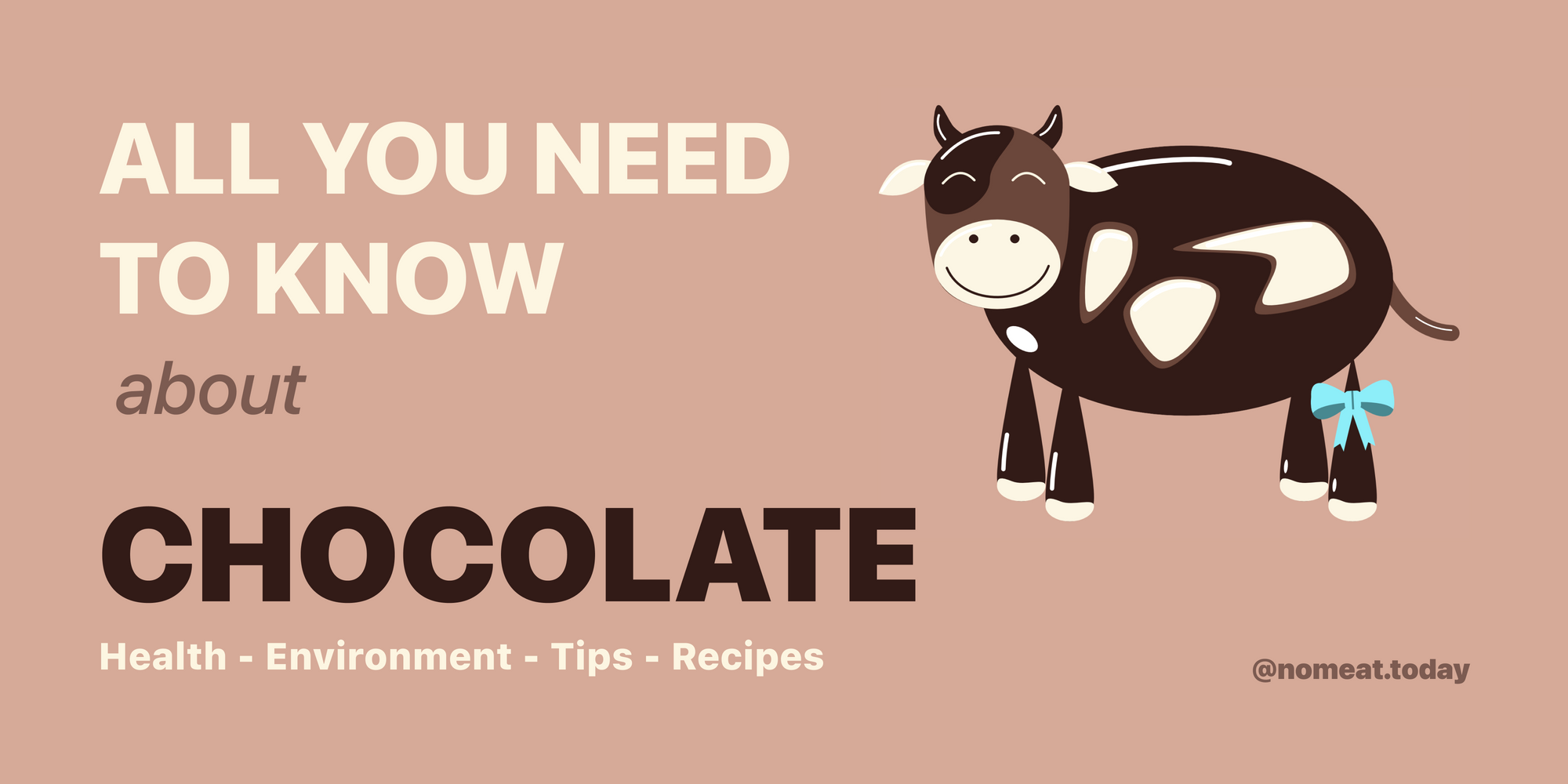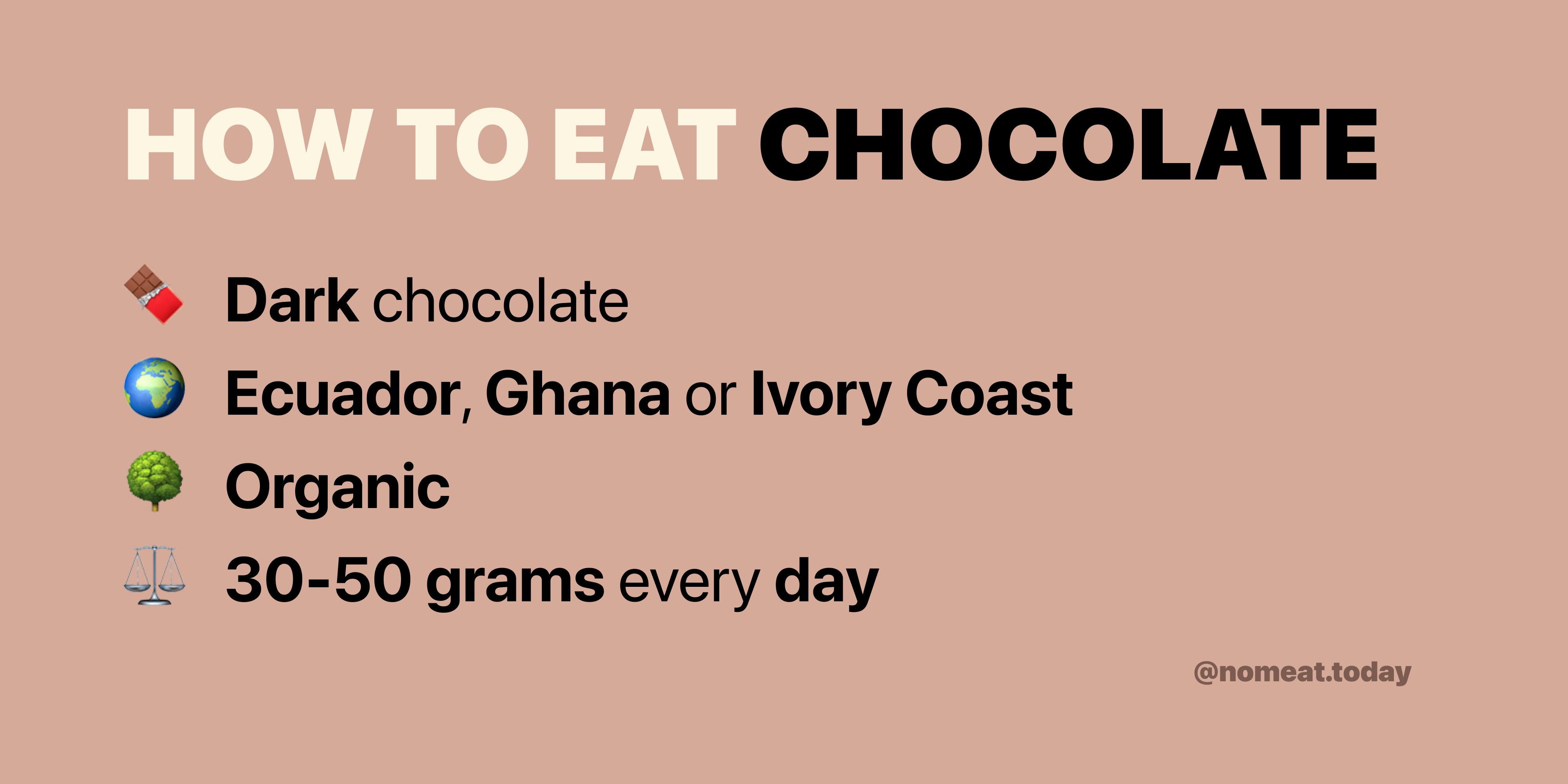All you need to know about chocolate

Easter, Christmas, stress, coffee time, there are a ton of occasions to eat chocolate.
But by the way, what's the impact of chocolate?
On your health, on the environment... Where does it come from?
We're here for you! We've gathered all available and reliable resources in one place. So you'll know how to choose when buying your next chocolate bar!
📱Self-promotion: No Meat Today helps you on your journey to eating less meat, whatever your motivations are.
💡For the ones who won’t eat meat on Easter Sunday, you’ll get a special Easter Cow on No Meat Today app. Don’t miss it!
TL;DR

Basics
Chocolate appeared in Mexico during the Mayas, Incas, and Aztecs period. They cultivated the cacao tree. It was used as an aphrodisiac, and only accessible for the affluent. Later on, because of its high price, chocolate was replaced by coffee and tea as the main drink.
Wording
- Cacao is the tree and its dried seeds prior to processing.
- Cocoa is after processing (roasting and grinding).
- Chocolate is the food prepared from roasted cacao seeds.
Where does it grow?
Nowadays, cocoa is mainly grown in West Africa, South America and Indonesia.
Now that we're good on the basics, we can start digging.
Is chocolate good for my health?
When going through the first results on Google on the impact of chocolate on health, we go from “let’s go, you should eat dark chocolate everyday”, to “keep an eye on high blood pressure, coronary artery disease”.
So, where are we at?
👍 Benefits
- Reduce stress
Cocoa contains potassium, phosphorus, copper, iron, zinc, and magnesium, which potentiate the health benefits of chocolate. Chocolate also contains valeric acid which acts as a stress reducer despite the presence of the stimulants caffeine and theobromine. A study in Switzerland confirmed that chocolate alleviates stress. Following 14 days of dark chocolate ingestion, stress parameters in the adults exhibiting high anxiety profiles became comparable with the low-stress subjects.(1) - Cardiovascular prevention
We need to talk about flavonoids. They are a class of polyphenolic secondary metabolites. Most of us don't understand what that means. What it does is much more interesting. Reports indicate that the main flavonoids found in cocoa, flavan-3-ols and their oligomeric derivatives, procyanidins, have a variety of beneficial actions, including antioxidant protection and modulation of vascular homeostasis. A study has concluded that the daily consumption of dark chocolate could be an effective cardiovascular preventive strategy in patients with metabolic disease. (2) Cocoa has the maximum levels of flavonoids, greater than even tea and wine. Dark chocolate contains considerably higher amounts of flavonoids than milk chocolate. Studies are still debating these benefits. (3) - Reduce blood pressure
Consumption of dark chocolate bars for 15 days has been reported to reduce systolic blood pressure in healthy subjects as well as in young and elderly hypertensive patients. (4) Other studies have contradicted this argument. (5) - Body weight loss
Cocoa consumption led to a significant decrease in total body weight of subjects, according to this study. (6) - Increase cognitive performance
A study has reported better cognitive performance with chocolate intake. (7)
👎 Drawbacks
Earlier, chocolate used to be criticized for its fat content and its consumption was a sin rather than a remedy, associated with acne, caries, obesity, high blood pressure, coronary artery disease and diabetes.
Nowadays, literature on drawbacks produced by chocolate is scarce when compared with the plenty of studies on the benefits.
- Quantity
Many physicians tended to warn patients about the potential health hazards of consuming large amounts of chocolate. - Lipids
The lipid content of chocolate is relatively high; however, one third of the lipid in cocoa butter is composed of the fat stearic acid, which exerts a neutral cholesterolemic response in humans. (8)
How often should I eat?
Nutritionists recommend consuming chocolate often, in small portions. The daily allowance for adult men and women without health problems is 30-50 grams of dark chocolate every day. With high physical exertion, an increase in the norm by 1.5 times is allowed. Doctors recommend eating milk and white chocolate - no more than 20 grams per day.
Anything more than that, you may be consuming too many calories.
Is it good for longevity?
Studies have suggested that dark chocolate is good for the heart and may boost longevity. Research based on Harvard graduates showed chocolate eaters lived a year or so longer than those who did not indulge. Those who ate one to three bars a month came out best, with a 36 per cent lower risk of premature death. Antioxidants, especially in dark chocolate, may be responsible. (9)
⚠️ Disclaimer: The contents of this website are for educational purposes and are not intended to offer personal medical advice. Never disregard professional medical advice or delay in seeking it because of something you have read on this website.
Is chocolate good or bad for the environment?
Greenhouse gas emissions
The emissions from chocolate varies A LOT depending on the country it comes from.
- Indonesia. Between 116 and 257kg CO2e (10)
- Brazil and Columbia. Between 3.4 and 11.7kg CO2e (11)
- Ghana, Ecuador and Ivory Coast. Between 1.8 and 4.9kg CO2e (12) 🥇
Comparisons
🐂 Beef
- Indonesia. Between 225 and 365kg CO2e (13)
- France. Between 42 and 55kg CO2e (14)
- Ireland. Between 36 and 46kg CO2e (15) 🥇
🐑 Lamb & Mutton
- Australia. Between 21 and 61kg CO2e (16) 🥇
- France. Between 38 and 72kg CO2e (17)
- Ireland. Between 40 and 58kg CO2e (18)
🍏 Apple
- France. Between 0.2 and 0.6kg CO2e (19) 🥇
- New Zealand. Between 0.3 and 1.2kg CO2e (20)
💦 Water use (21)
- 🍫 Chocolate: 541L per kilogram of food
- 🐂 Beef (beef herd): 1451L
- 🐑 Lamb & mutton: 1803L
- 🍏 Apples: 180L
🌳 Land use (22)
- 🍫 Chocolate: 68.96 m² per kilogram of food
- 🐂 Beef (beef herd): 326m²
- 🐑 Lamb & Mutton: 369m²
We also have to take into account that conventional farming uses monoculture. After two decades the soil is not fertile enough and farmers have to expand their plantations on forest. According to Consoglobe, 13% of the surface of the forest in Ivory Coast has been cut to grow cacao. (23)
Pesticides
Chocolate producers often use pesticides. However, the seed is protected by a shell. The fruit inside is therefore more protected. We eat less pesticides in chocolate than in apples.
So the risk on you is low, but the risk on people working in cacao farming is high. The access to information and protection is low. Make sure to choose organic chocolate when buying some.
Tips when cooking it
🚫 Don’t throw away chocolate that looks like it's covered in white dust. It is safe to eat and doesn’t affect the flavor.
🚫 Don’t buy chocolate chips if you plan to melt them. They contain stabilizers that help them hold their shape, which can make melted chocolate lumpy.
🚫 Once chocolate is melted don’t use or add cold stuff (cold, metal spoon to stir, very cold flavorings, cold bowl…). It will make the chocolate grainy, and turn instantly into a hard, solid lump. Once the chocolate becomes a hard lump, it cannot be undone.
✅ Pay attention to cacao percentages. The lower it is, the higher the “rest” is. Rest meaning anything from sugar to milk to flavorings to emulsifiers.
✅ The best way to melt chocolate is a glass bowl over a pan of simmering water. It reduces the risk of burning.
✅ Use wooden spoons to stir, make sure bowls and other equipment and ingredients are at room temperature (see #3).
Recipes with chocolate

- 🤌 Classic: Fudgy dark chocolate brownies
- 🤯 Surprising: Dark chocolate pumpkin truffles
- 🛋 Comfort: Chocolate Salted peanut butter caramel layer cake
- 🏃 In a hurry: 10-minute-dark-chocolate-brownie
- 🧑🍳 Michelin Star: Dark chocolate delice with coffee ice cream
Sources
️⚠️ Disclaimer: if you discover new reliable sources that could improve our post, feel free to reach out to us [email protected]
- Martin FPJ, Rezzi S, Pere-Trepat E, et al., Metabolic Effects of Dark Chocolate Consumption on Energy, Gut Microbiota, and Stress-Related Metabolism in Free-Living Subjects. J. Proteome Res. 2009;8:5568-79
- Zomer E, Owen A, Magliano DJ, Liew D, Reid CM. The effectiveness and cost effectiveness of dark chocolate consumption as prevention therapy in people at high risk of cardiovascular disease: best case scenario analysis using a Markov model. BMJ. 2012; 344:e3657
- Kerimi, A and Williamson, G (2015) The cardiovascular benefits of dark chocolate. Vascular Pharmacology, 71. 11 - 15. ISSN 1537-1891
- Grassi D, Lippi C, Necozione S, Desideri G, Ferri C. Short-term administration of dark chocolate is followed by a significant increase in insulin sensitivity and a decrease in blood pressure in healthy persons. Am J Clin Nutr. 2005;81:611-4
- Alonso A, de la Fuente C, Beunza JJ, Sanchez-Villegas A, Martinez Gonzalez MA. Chocolate consumption and incidence of hypertension. Hypertension. 2005;46:e21- e22.
- Matsui N, Ito R, Nishimura E, et al, Ingested cocoa can prevent high fat diet induced obesity by regulating the expression of genes for fatty acid metabolism. Nutrition. 2005;21:594-601.
- Nurk E, Refsum H, Drevon CA, et al, Intake of Flavonoid-Rich Wine, Tea, and Chocolate by Elderly Men and Women Is Associated with Better Cognitive Test Performance. J. Nutr. 2009;139:120-7.
- Francene M Steinberg, Monica M Bearden, Carl L Keen, Cocoa and chocolate flavonoids: Implications for cardiovascular health, Journal of the American Dietetic Association, Volume 103, Issue 2, 2003, Pages 215-223, ISSN 0002-8223
- https://www.hsph.harvard.edu/nutritionsource/food-features/dark-chocolate/
- Utomo et al. (2016)
- Schroth et al. (2016) Ortiz-Rodríguez et al. (2016)
- Afrane et al. (2013); Borg and Selmer (2012), Eitner et al. (2012), Nemecek et al. (2015)
- Widi et al. (2015)
- Nguyen et al. (2013b)
- Casey and Holden (2006a); Blonk et al. (2008)
- Wiedemann et al. (2015c)
- Dakpo et al. (2013)
- O'Brien et al. (2016a)
- Koch and Salou (2015)
- Milà i Canals (2003)
- Poore, J., & Nemecek, T. (2018). Reducing food’s environmental impacts through producers and consumers. Science, 360(6392), 987-992
- Poore, J., & Nemecek, T. (2018). Reducing food’s environmental impacts through producers and consumers.
- https://www.consoglobe.com/cacao-chocolat-equitables-2332-cg
